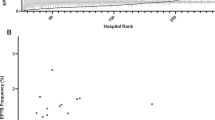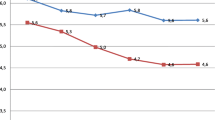Abstract
Late preterm (LPT) neonates (34 0/7th–36 6/7th weeks’ gestation) account for 70% of all premature births in the United States. LPT neonates have a higher morbidity and mortality risk than term neonates. LPT birth rates vary across geographic regions. Unwarranted variation is variation in medical care that cannot be explained by sociodemographic or medical risk factors; it represents differences in health system performance, including provider practice variation. The purpose of this study is to identify regional variation in LPT births in North Carolina that cannot be explained by sociodemographic or medical/obstetric risk factors. We searched the NC State Center for Health Statistics linked birth–death certificate database for all singleton term and LPT neonates born between 1999 and 2006. We used multivariable logistic regression analysis to control for socio-demographic and medical/obstetric risk factors. The main outcome was the percent of LPT birth in each of the six perinatal regions in North Carolina. We identified 884,304 neonates; 66,218 (7.5%) were LPT. After multivariable logistic regression, regions 2 (7.0%) and 6 (6.6%) had the highest adjusted percent of LPT birth. Analysis of a statewide birth cohort demonstrates regional variation in the incidence of LPT births among NC’s perinatal regions after adjustment for sociodemographic and medical risk factors. We speculate that provider practice variation might explain some of the remaining difference. This is an area where policy changes and quality improvement efforts can help reduce variation, and potentially decrease LPT births.



Similar content being viewed by others
References
Martin, J. A., Hamilton, B. E., Sutton, P. D., et al. (2010). Births: Final data for 2007. National Vital Statistics System, 58(24), 1–85.
Raju, T. N., Higgins, R. D., Stark, A. R., et al. (2006). Optimizing care and outcome for late-preterm (near-term) infants: a summary of the workshop sponsored by the National Institute of Child Health and Human Development. Pediatrics, 118(3), 1207–1214.
Martin J. A., Hamilton B. E., & Sutton P. D., et al. (2009). Births: Final data for 2006. Hyattsville, MD: National Center for Health Statistics. Contract No.: 7.
Engle, W. A., Tomashek, K. M., & Wallman, C. (2007). “Late-preterm” infants: A population at risk. Pediatrics, 120(6), 1390–1401.
Morse, S. B., Zheng, H., Tang, Y., et al. (2009). Early school-age outcomes of late preterm infants. Pediatrics, 123(4), e622–e629.
Petrini, J. R., Dias, T., McCormick, M. C., et al. (2009). Increased risk of adverse neurological development for late preterm infants. Journal of Pediatrics, 154(2), 169–176.
Thompson, L. A., Goodman, D. C., Chang, C. H., et al. (2005). Regional variation in rates of low birth weight. Pediatrics, 116(5), 1114–1121.
Behrman, R. E., & Butler, A. S. (Eds.). (2006). Preterm birth: Causes, consequences, and prevention. Washington DC: Institute of Medicine of the National Academies Press.
Brook, R. H., & Lohr, K. N. (1985). Efficacy, effectiveness, variations, and quality. Boundary-crossing research. Medical Care, 23(5), 710–722.
Wennberg, J., & Gittelsohn, A. (1982). Variations in medical care among small areas. Scientific American, 246(4), 120–134.
Goodman, D. C. (2009). Unwarranted variation in pediatric medical care. Pediatric Clinics of North America, 56(4), 745–755.
Kotelchuck, M. (1994). An evaluation of the Kessner adequacy of prenatal care index and a proposed adequacy of prenatal care utilization index. American Journal of Public Health, 84(9), 1414–1420.
Fuchs, K., & Gyamfi, C. (2008). The influence of obstetric practices on late prematurity. Clinics in Perinatology, 35(2), 343–360.
McIntire, D. D., & Leveno, K. J. (2008). Neonatal mortality and morbidity rates in late preterm births compared with births at term. Obstetrics and Gynecology, 111(1), 35–41.
Holland M. G., Refuerzo J. S., & Ramin S. M., et al. (2009). Late preterm birth: How often is it avoidable? American journal of obstetrics and gynecology, 201(4):404 e1–404.e4.
Slattery, M. M., Geary, M., & Morrison, J. J. (2008). Obstetric antecedents for preterm delivery. Journal of Perinatal Medicine, 36(4), 306–309.
Reddy, U. M., Ko, C. W., Raju, T. N., et al. (2009). Delivery indications at late-preterm gestations and infant mortality rates in the United States. Pediatrics, 124(1), 234–240.
Laughon, S. K., Reddy, U. M., Sun, L., et al. (2010). Precursors for late preterm birth in singleton gestations. Obstetrics and Gynecology, 116(5), 1047–1055.
Chassin, M. R., Kosecoff, J., Park, R. E., et al. (1987). Does inappropriate use explain geographic variations in the use of health care services? A study of three procedures. Journal of the American Medical Association, 258(18), 2533–2537.
Roblin, D. W., Richardson, D. K., Thomas, E., et al. (2000). Variation in the use of alternative levels of hospital care for newborns in a managed care organization. Health Services Research, 34(7), 1535–1553.
Jason, C. J., Samuhel, M. E., Glick, B. J., et al. (1986). Geographic distribution of unexplained low birth weight. Journal of Occupational Medicine, 28(8), 728–740.
Helfand, M., & Zimmer-Gembeck, M. J. (1997). Practice variation and the risk of low birth weight in a public prenatal care program. Medical Care, 35(1), 16–31.
Glantz, J. C. (2003). Labor induction rate variation in upstate New York: What is the difference? Birth, 30(3), 168–174.
Baicker, K., Buckles, K. S., & Chandra, A. (2006). Geographic variation in the appropriate use of cesarean delivery. Health Affairs (Millwood), 25(5), w355–w367.
Clark S. L., Belfort M. A., & Hankins G. D., et al. (2007). Variation in the rates of operative delivery in the United States. American Journal of Obstetrics and Gynecology, 196(6):526 e1–526.e5.
Tromp, M., Eskes, M., Reitsma, J. B., et al. (2009). Regional perinatal mortality differences in the Netherlands; care is the question. BMC Public Health, 9, 102.
Ananth, C. V., & Vintzileos, A. M. (2006). Epidemiology of preterm birth and its clinical subtypes. Journal of Maternal-Fetal and Neonatal Medicine, 19(12), 773–782.
Wennberg, J. E. (1984). Dealing with medical practice variations: A proposal for action. Health Affairs (Millwood), 3(2), 6–32.
Eddy, D. M. (1984). Variations in physician practice: The role of uncertainty. Health Affairs (Millwood), 3(2), 74–89.
Davidoff, M. J., Dias, T., Damus, K., et al. (2006). Changes in the gestational age distribution among US singleton births: Impact on rates of late preterm birth, 1992 to 2002. Seminars in Perinatology, 30(1), 8–15.
MacDorman, M. F., Declercq, E., & Zhang, J. (2010). Obstetrical intervention and the singleton preterm birth rate in the United States from 1991–2006. American Journal of Public Health, 100(11), 2241–2247.
Schoendorf, K. C., & Branum, A. M. (2006). The use of United States vital statistics in perinatal and obstetric research. American Journal of Obstetrics and Gynecology, 194(4), 911–915.
Parker, J. D., & Schoendorf, K. C. (2002). Implications of cleaning gestational age data. Paediatric and Perinatal Epidemiology, 16(2), 181–187.
Qin, C., Dietz, P. M., England, L. J., et al. (2007). Effects of different data-editing methods on trends in race-specific preterm delivery rates, United States, 1990–2002. Paediatric and Perinatal Epidemiology, 21(Suppl 2), 41–49.
Mustafa, G., & David, R. J. (2001). Comparative accuracy of clinical estimate versus menstrual gestational age in computerized birth certificates. Public Health Reports, 116(1), 15–21.
Qin, C., Hsia, J., & Berg, C. J. (2008). Variation between last-menstrual-period and clinical estimates of gestational age in vital records. American Journal of Epidemiology, 167(6), 646–652.
Wingate, M. S., Alexander, G. R., Buekens, P., et al. (2007). Comparison of gestational age classifications: date of last menstrual period vs. clinical estimate. Annals of Epidemiology, 17(6), 425–430.
National Center for Health Statistics. (2010). Retrieved September 26th, 2010 from www.marchofdimes.com/peristats.
Acknowledgments
Dr. Smith received support from NICHD 1K23HD060040-01 and DHHS-1R18AE000028-01. Dr. Laughon receives support from the US government for his work in pediatric and neonatal clinical pharmacology (Government Contract HHSN267200700051C, PI: Benjamin) and from NICHD (1K23HL092225-01). We would like to thank the North Carolina State Center for Health Statistics and the Division of Medical Assistance at the North Carolina Department of Health and Human Services for providing access to the data used for this study.
Author information
Authors and Affiliations
Corresponding author
Rights and permissions
About this article
Cite this article
Aliaga, S.R., Smith, P.B., Price, W.A. et al. Regional Variation in Late Preterm Births in North Carolina. Matern Child Health J 17, 33–41 (2013). https://doi.org/10.1007/s10995-012-0945-7
Published:
Issue Date:
DOI: https://doi.org/10.1007/s10995-012-0945-7




